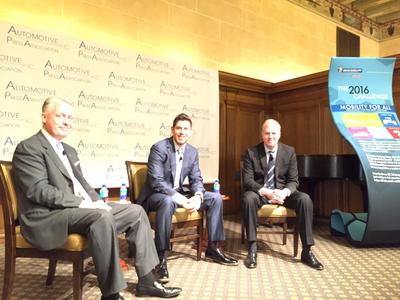Race Cars in 2030? What They'll Be Is Anyone's Guess
By Martha Hindes
Senior Editor
Michigan Bureau
The Auto
Channel
Detroit April 20, 2016; Want to compare how current vehicles relate to those a few years ago? Think of a 1990s-era pager when someone who got a message found a public phone booth and dropped in a quarter to return the call. Not that long ago, really. But a millennium apart from today's smartphone world reality.
Looking for a racing car in another dozen years? According to three industry racing experts at the annual Michelin Design Challenge panel, that pager analogy won't be so far off. They participated Wednesday at Michelin's "Le Mans 2030: Design for the Win" held before the Automotive Press Association at the Detroit Athletic Club in the Motor City.
According to those experts looking at the vehicle development horizon, a race car -- probably the sexiest and most alluring vehicle anyone could think of -- brings with it an explosion of challenges. Those are complicated by the continuing evolution of power train technology, electrification, use of environmentally-sustainable materials and the primary need to make it so irresistibly alluring to look at that one is riveted to the races where it performs.
That appeal is evident outside the United States. Last year the fabled 24 Hours of Le Mans -- the nearly century-old holy grail of endurance auto racing held annually in France -- drew some 78 million viewers worldwide who watched it live. Sometimes referred to as "the ultimate (vehicle) battleground," it has become the prime testing ground for innovation, creativity, environmental protection, and quite possibly some autonomous driving aspects in the future.
Good race car design begins with aesthetics that need to find the perfect balance with the uncertain direction technology is evolving. No one knows at this juncture whether those vehicles will be powered electrically, by fuel cells, by hybrid engines, or by continuing advances in internal combustion engines that auto makers continue to fine tune. What is certain is the evolution will continue at warp speed.
But aesthetics are primary, not just for an auto maker's racing or supercars, but as an identity that flows down through every vehicle it makes, according to Dave Marek, Executive Creative Director for Acura, who was one of the three panelists. "We want to embody that for the public," said Marek. "It says 'This is who we are'."
"Racing is now the leader in what happens to passenger cars," said panelist Doug Fehan, Program Manager for Corvette Racing that has won eight times at Le Mans. "All things are interlocking." He said today's vehicles, like consumer electronics, are so complex and beyond comprehension that such technology is seen as "magic" by consumers.
And evolution will continue to be on a micro scale covering all aspects, according to motor racing designer and innovator, Ben Bowlby, also a panelist. "It has to have the ability to suit humanity's needs," he said.
While some 13 auto makers such as General Motors with its Corvette, Porsche, Audi, Aston Martin, Ferrari, Toyota and Ford currently compete at Le Mans, more cars not represented could become participants as they continue to develop leading edge innovation in their race-worthy vehicles.
This is the 17th annual Michelin Design Competition, with winners to be announced in September. The competition pits auto designers internationally for top honors. Some 1090 entries were received by the October, 2015 deadline for this year's competition.



